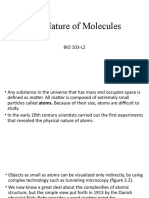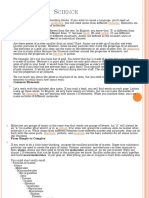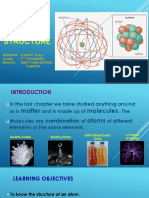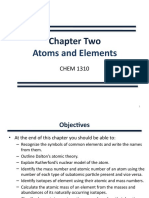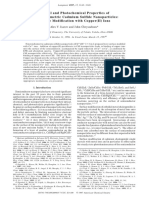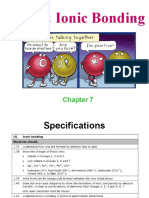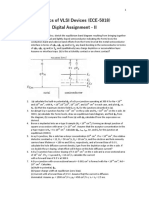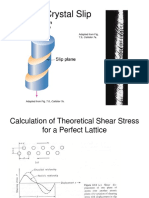0% found this document useful (0 votes)
44 views19 pagesStructure of Matter Overview
The document discusses the structure of matter including:
- Pure substances can be simple substances made of one element or compound substances made of multiple elements.
- Atoms are made of protons, neutrons, and electrons. Electrons orbit the nucleus which contains protons and neutrons.
- Atomic structure and models have evolved over time from plum pudding to Rutherford's model with electrons orbiting a nucleus.
- The atomic number identifies elements based on their number of protons while the mass number includes protons and neutrons. Isotopes are atoms of the same element with different numbers of neutrons. Ions are formed when atoms gain or lose electrons.
Uploaded by
Pechito LokoCopyright
© © All Rights Reserved
We take content rights seriously. If you suspect this is your content, claim it here.
Available Formats
Download as PPTX, PDF, TXT or read online on Scribd
0% found this document useful (0 votes)
44 views19 pagesStructure of Matter Overview
The document discusses the structure of matter including:
- Pure substances can be simple substances made of one element or compound substances made of multiple elements.
- Atoms are made of protons, neutrons, and electrons. Electrons orbit the nucleus which contains protons and neutrons.
- Atomic structure and models have evolved over time from plum pudding to Rutherford's model with electrons orbiting a nucleus.
- The atomic number identifies elements based on their number of protons while the mass number includes protons and neutrons. Isotopes are atoms of the same element with different numbers of neutrons. Ions are formed when atoms gain or lose electrons.
Uploaded by
Pechito LokoCopyright
© © All Rights Reserved
We take content rights seriously. If you suspect this is your content, claim it here.
Available Formats
Download as PPTX, PDF, TXT or read online on Scribd
/ 19












